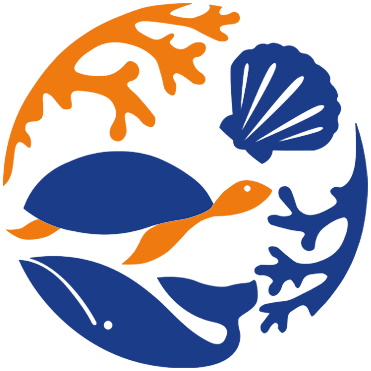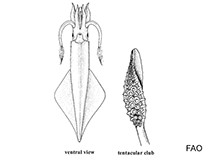Loliolus uyii (Wakiya & Ishikawa, 1921)
Little squid
Upload your photos
Google image | No image available for this species;
drawing shows typical species in Loliginidae.
Google image | No image available for this species;
drawing shows typical species in Loliginidae.
Classification / Names Populärnamn | synonymer | CoL | ITIS | WoRMS
Cephalopoda | Myopsida | Loliginidae
Environment: milieu / climate zone / djupintervall / distribution range Ekologi
Ej vandrande (Ref. 75927); djupintervall 50 - 150 m (Ref. 275), usually ? - 150 m (Ref. 75927). Tropical; 35°N - 6°N, 76°E - 136°E
Distribution Länder | FAO områden | Ekosystem | Förekomster | Utplanteringar
Indo-West Pacific.
Length at first maturity / Size / Weight / Age
Könsmognad: Lm ? range ? - ? cm Max length : 10.0 cm ML hane/ej könsbestämd; (Ref. 275)
Short description Morfologi
Mantle cylindrical, short, its width about 25% of the mantle length. Fins rhomboidal, length about 60% of mantle length. Tentacular clubs expanded, suckers 56-60, quadriserial, 8 proximal suckers greatly enlarged with smooth rings, teeth absent; medial and distal rings with 7 to 10 very low, broad, plate-like or semilunar teeth. Arm suckers biserial; sucker rings on arm III with 3 to 6 truncate teeth. Left ventral arm hectocotylized along distal 2/3 with about 75 suckerless papillae. (Refs. 275, 128027).
A small-sized, coastal species found ca. 50 m depth (Refs. 275, 128024) (Ref. 275).
Life cycle and mating behavior Könsmognad | Reproduktion | Lek | Eggs | Fecundity | Larvae
Members of the class Cephalopoda are gonochoric. Male and female adults usually die shortly after spawning and brooding, respectively. Mating behavior: Males perform various displays to attract potential females for copulation. During copulation, male grasp the female and inserts the hectocotylus into the female's mantle cavity where fertilization usually occurs. Life cycle: Embryos hatch into planktonic stage and live for some time before they grow larger and take up a benthic existence as adults.
Main reference
referenser | Koordinator | Medarbetare
Roper, C.F.E., M.J. Sweeney and C.E. Nauen. 1984. (Ref. 275)
IUCN Red List Status
(Ref. 130435: Version 2024-2)
Data deficient (DD) ; Date assessed: 01 July 2015
CITES status (Ref. 108899)
Not Evaluated
CMS (Ref. 116361)
Not Evaluated
Threat to humans
Human uses
| FishSource |
Verktyg
Ytterligare information
Trophic Ecology
Födoslag
Födosammansättning
Födointag
Food rations
Predatorer
Födosammansättning
Födointag
Food rations
Predatorer
Ekologi
Population dynamics
Tillväxt
Max. ages / sizes
Length-weight rel.
Length-length rel.
Length-frequencies
Mass conversion
Rekrytering
Abundans
Max. ages / sizes
Length-weight rel.
Length-length rel.
Length-frequencies
Mass conversion
Rekrytering
Abundans
Life cycle
Distribution
Human Related
Aquaculture profiles
Stamps, coins, misc.
Stamps, coins, misc.
Outreach
referenser
Internet-källor
BHL | BOLD Systems | CISTI | DiscoverLife | FAO(Publication : search) | Fishipedia | GenBank (genome, nucleotide) | GloBI | Gomexsi | Google Books | Google Scholar | Google | PubMed | Tree of Life | Wikipedia (Go, sök) | Zoological Record



